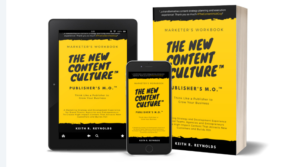An ROI model makes your business case and guides your team throughout your content hub’s operation. Publio’s ROI Calculator can help justify marketing spend.
Guest Post By Jill Campbell
The toughest part of going after the budget for any new strategic initiative might be building the business case for the C-suite, which must include metrics and projections.
The early part of my marketing career had nothing to do with metrics. Marketing teams spent a lot of their time fighting widely-held beliefs that marketing is strictly a cost center and that “anyone can be a marketer.” There was really no way to build a business case that measured an initiative or tied the cost of a marketing program or campaign directly to the acquisition of new customers or increased revenue. That has all changed with digital marketing.

Learn more about achieving your business objectives with content marketing.
Today there’s content marketing, where the most difficult part is explaining to non-marketers the value of your initiative — let alone demonstrating how a content hub can positively impact your company’s revenue and profit. The stakes are high. Imagine pitching the concept to the C-suite, where your next performance review or bonus may well be based on how you move the company’s revenue needle.
Two truths should inform your pitch:
- The C-suite is not looking for ways to spend (more) money.
- The C-suite is looking for ways to make (more!) money.
With content marketing, there’s a right way to do it and a not-so-right way. A lot of marketers naturally fall into the latter category, because they don’t develop the right metrics from the start. Even still, marketing can be a squishy science. We focus on telling a good story, providing incisive insight, a great tag line, and eye-catching branding. But too many people still don’t understand the connection between what we do to catch our target audiences’ eyes, and the direct link to sales and revenue.
I joined the Publio team because I was intrigued by the proposition that a content marketer should “think like a publisher.” Consider some of the top publications: The New York Times, The Wall Street Journal, Sports Illustrated, Slate.com, The National Review, CNN or The Financial Times. Each and every one of these publications must turn a profit, which is to say, their products – content – must generate revenue. That’s easy for them because their platforms support sales of advertising such as air time, banner ads, sponsorships or reference retargeting.
To implement a content hub strategy, you must think — and act! – like a publisher.
This is the crux of Publio’s value proposition: To implement a content hub strategy, you must think — and act! – like a publisher. Yes, develop a newsroom culture for journalistic standards. Yes, hold regular editorial meetings. Yes, maintain an editorial calendar. Yes, promote and distribute your content. Most critically, tackle the one thing that really, truly matters to the C-suite: How will you monetize your content hub?
If you can demonstrate that, you will get the money you need to launch your content hub.
Demystifying Content Marketing ROI
Do you have integrated marketing and sales systems in place? Do you regularly measure your success in financial terms? When you update the C-suite on your team’s latest return on investment (ROI), is the response “wow!” or “meh?”
A “wow” response is much more likely if you build your ROI model early in the process.
Download your free ROI calculator here
Start with a comprehensive list of your program expenses, beginning with the cost of building and maintaining your content hub’s digital website. Include your staff’s time, agency engagement and other external resources such as copywriters, videographers, designers, and photographers, paid social and PPC, and digital/print advertising.
Be as honest as you are comprehensive, right down to those unanticipated expenses that get added to the budget later the cycle. This is your first-year program cost. It’s even better when you schedule your expenses on a monthly basis throughout the calendar year, so that you (and the C-suite) can project when and how you will invest your budget.
Moving down the ROI calculator, enter the following inputs:
- Annual Contract Value (ACV): How much is a sale worth?
- Lifetime Value (LTV): The number of years in a typical sales contract.
You may need to work directly with the sales team to obtain this information, especially if you don’t yet have an integrated marketing and sales system.
For the visitor’s funnel, enter these projections, which should be based on the numbers you currently have in your CRM:
- Total Website Visitors: Number of unique visitors to your site.
- Visitor -> Marketing Lead Conversion Rate: Conversion rate from visitor to marketing lead.
- Total Marketing Leads: Estimated total marketing leads based on total website visitors and visitor conversion rate.
- Marketing Lead -> MQL Conversion Rate: Conversion rate from marketing to marketing qualified lead.
- Total Marketing Qualified Leads (MQLs): Marketing Qualified Leads from all sources.
- Marketing Qualified Lead -> Opportunity Conversion Rate: Conversion rate from marketing qualified lead to opportunity.
- Total Opportunities: Total number of created business opportunities.
- Opportunity -> Sale Conversion Rate: Conversion rate from opportunities to sales.
- Total Sales: Total number of projected new unit sales.
Your output may look something like this:

This is an ROI Calculator we use to help clients right-size their content marketing.
In the example above, a first-year investment of just under a half-million dollars will return around $1.3 million in revenue.
Now, you’ve got the C-suite’s attention. You’re making the CMO look good, the CFO is happy to find the money for your content hub, and everyone is thinking about growth.
The key to content marketing success is to include all sources of traffic from your content hub into your marketing automation and CRM systems and processes. Your model will provide the necessary metrics to support your ROI, and provide the feedback that will enable your content hub’s continuous improvement.
Your Content Marketing Modus Operandi (M.O.)
The Publisher’s M.O.™ is a content hub marketing strategy that helps your team create impactful content and experiences that attract new customers and ultimately drive increased revenue.
To learn more, order your copy of The New Content Culture: Think Like a Publisher to Grow Your Business. The book walks you through content hubs, how to build successful content marketing programs, and a 7-plus-7 model to build and implement your marketing strategy.
Jill Campbell is a strategic marketing and communications expert with a 25+ year career in B2B and B2C multi-channel marketing. She has worked in corporate, professional services, and entrepreneurial settings, as well as creative agencies large and small. She has extensive experience in the world of event marketing and management, and a public and media relations background. She is also a non-practicing attorney, which guides both her perspective and approach.

